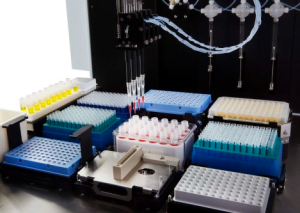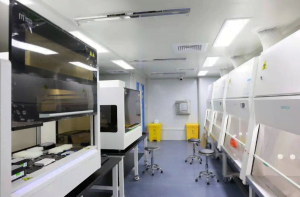Inside living organisms, nucleic acids usually exist in association with proteins. Nucleic acid extraction is the process of isolating and purifying nucleic acids (DNA, RNA) from cellular components based on their biochemical properties. Nucleic acid extraction is fundamental for almost all nucleic acid detection and is essential for molecular biology experiments such as cloning, Blot Selatan, and gene typing.
How to conduct successful nucleic acid extraction
The success of nucleic acid extraction depends on several factors:
- High purity of extracted nucleic acids, especially removing amplification inhibitors: The presence of amplification inhibitors like metal ions or proteins in the sample can significantly hinder subsequent PCR amplification, leading to distorted test results.
- High extraction efficiency: For samples containing only trace amounts of nucleic acids, efficient extraction methods are necessary for subsequent DNA amplification and analysis.
- Quantitative extraction: Quantitative extraction helps improve the success rate of amplification and increases the accuracy of test results.
- Automated extraction: Automated extraction not only greatly improves operational efficiency but also eliminates human contamination, making test results more reliable and objective.
- Low extraction cost is the basis for widespread application in large-scale scenarios.

Introduction to Common DNA Extraction Methods
Phenol-Chloroform Method:
The phenol-chloroform method of DNA extraction typically involves adding an equal volume of phenol-chloroform mixture to cell lysate after cell disruption. Due to DNA’s solubility in water but not in organic solvents, proteins are denatured and precipitated in the presence of the organic solvent layer, while DNA remains in the aqueous layer.
Akhirnya, DNA is separated, precipitated, and recovered from the aqueous layer using ethanol. This method is widely used for various biological samples, especially effective for degraded, aged, and contaminated specimens such as nails and hair. Although it yields high-purity and intact DNA, the extraction process involves multiple complex centrifugation steps, making it time-consuming and prone to sample cross-contamination, resulting in low DNA yields, thus unsuitable for large-scale extraction.
Salting-out Method:
The salting-out method separates DNA and RNA based on their differing solubilities in electrolyte solutions. Commonly, DNA is precipitated by adding 1 M sodium chloride to the DNA-containing solution, followed by mixing with chloroform containing a small amount of octanol to remove proteins. At this point, proteins form a gel layer between the aqueous and chloroform phases, while DNA remains in the upper aqueous phase.
DNA can then be precipitated from the aqueous phase using twice the volume of 95% etanol. This method is simple, fast, and uses commonly available laboratory reagents, avoiding procedural errors and improving DNA extraction quality, with stable and effective results.
Silica-based Adsorption Method:
The silica-based adsorption method extracts genomic DNA by exploiting the interaction between DNA molecules and silica nanoparticles under high ionic strength buffer conditions. As the negative charge on DNA molecules decreases, they bind to positively charged silica nanoparticles’ surfaces.
Cell lysate disruptors also interfere with the formation of DNA double-strand molecules, generating single-stranded DNA molecules that bind to silica surfaces through hydrogen bonds. By adjusting the pH of the high ionic strength buffer, DNA adsorption to the silica surface can be enhanced. Kemudian, DNA is eluted from the silica nanoparticles using buffers with specific pH values.
This method directly extracts genomic DNA from various biological samples, with easy and rapid operation, without requiring special equipment or organic solvents, ensuring no damage to the extracted DNA and meeting the needs of various molecular biology experiments such as PCR amplification, molecular hybridization, restriction enzyme digestion analysis, and gene chip analysis.
Ion Exchange Method:
The ion exchange method utilizes the interaction between positively charged amino groups on the DNA backbone and negatively charged phosphate groups on ion exchange resin surfaces. In a wide range of salt concentrations, both DNA and DEA groups can bind to each other. Washing with a medium-salt solution removes proteins and RNA impurities from the resin’s surface. Akhirnya, DNA bound to the resin is eluted using a high-salt acidic solution.
Magnetic Nanoparticle Adsorption Method:
Due to their specific binding with nucleic acids under certain conditions without binding to impurities such as proteins, sugars, and lipids in the sample, magnetic beads are widely used in DNA extraction and pathogen detection. The basic principle of the magnetic nanoparticle adsorption method involves using high-molecular-weight materials with positively charged chemical groups such as Fe3O4 as raw materials to prepare magnetic nanoparticles with positive charges.
These magnetic nanoparticles are added to the lysate after cell lysis, where DNA molecules quickly adsorb to the positively charged magnetic nanoparticles’ surfaces under slightly acidic (pH 5.0) conditions. Adsorbed DNA magnetic beads aggregate at the side of the test tube under the action of a magnetic field.
The liquid in the tube is discarded, and a washing buffer is added. After several washes, the tube is placed back in the magnetic field, and the magnetic beads aggregate on the tube wall. Kemudian, an alkaline buffer (such as TE buffer at pH 8.0) or a phosphate buffer (phosphate buffer, 0.2 mol/L NaH2PO4; 0.2 mol/L Na2HPO4) is used to elute DNA from the magnetic nanoparticles, obtaining a purified genomic DNA solution.
The DNA extraction method based on magnetic nanoparticles is a simple, fast, and effective DNA separation method that does not require centrifugation or column separation throughout the extraction process, can process multiple samples simultaneously, and can easily realize automated operation.

Principle of Automated Nucleic Acid Extraction
Currently, there are two main methods for nucleic acid extraction: manual extraction and automated extraction. Manual extraction requires simple materials but often introduces human errors to the extraction results. Repetitive extractions may lead to differences in DNA extraction yield and purity, affecting downstream biological experiments and diagnostic tests.
Karena itu, there is an urgent need to automate nucleic acid extraction. Automated extraction can significantly increase the yield, purity, and reproducibility of DNA extraction, ensuring a systematic process for downstream testing. It also holds positive implications for disease diagnosis and the response to outbreaks, especially concerning large sample sizes.
System Functions and Components
The nucleic acid extraction system is based on magnetic bead-based nucleic acid extraction technology, capable of fully automating the entire DNA extraction process.
The main steps involved include cell lysis, nucleic acid adsorption, nucleic acid purification, and magnetic bead elution. Reagents required for the experimental process include biological samples, magnetic beads, lysis buffer, washing buffer, and magnetic bead elution buffer.
Magnetic Separation Device Design Magnetic separation
It is a characteristic feature of magnetic bead-based nucleic acid extraction methods. Unlike liquid transfer methods, where magnetic beads are aggregated on the side wall of the reaction tube after magnetic separation and then transferred with the reaction liquid, the magnetic rod-type device aggregates magnetic beads on the outer wall of the magnetic rod sleeve and moves them through a transmission mechanism, avoiding complex liquid transfer processes.
The use of a magnetic rod-type device for magnetic separation in nucleic acid extraction instruments enables a compact, small, flexible, and stable system structure, overcoming the drawbacks of existing fully automated liquid handling workstations, which are large and bulky. It is the best choice for realizing a small, portable nucleic acid extraction instrument.
System Control Platform Commands
The System Control Platform Commands are accepted by the system control platform, parsed, and then sent to the corresponding functional modules to complete specific operations. At the same time, the system control platform receives real-time feedback from each functional module.
The functional modules of this system include motion control modules, temperature control modules, and human-machine interaction modules, each completing different functions under coordinated control. The fully automated nucleic acid extraction system integrates hardware and software, using an embedded microprocessor, belonging to embedded systems.
Karena itu, the design of the fully automated nucleic acid extraction system follows embedded system design methods.
